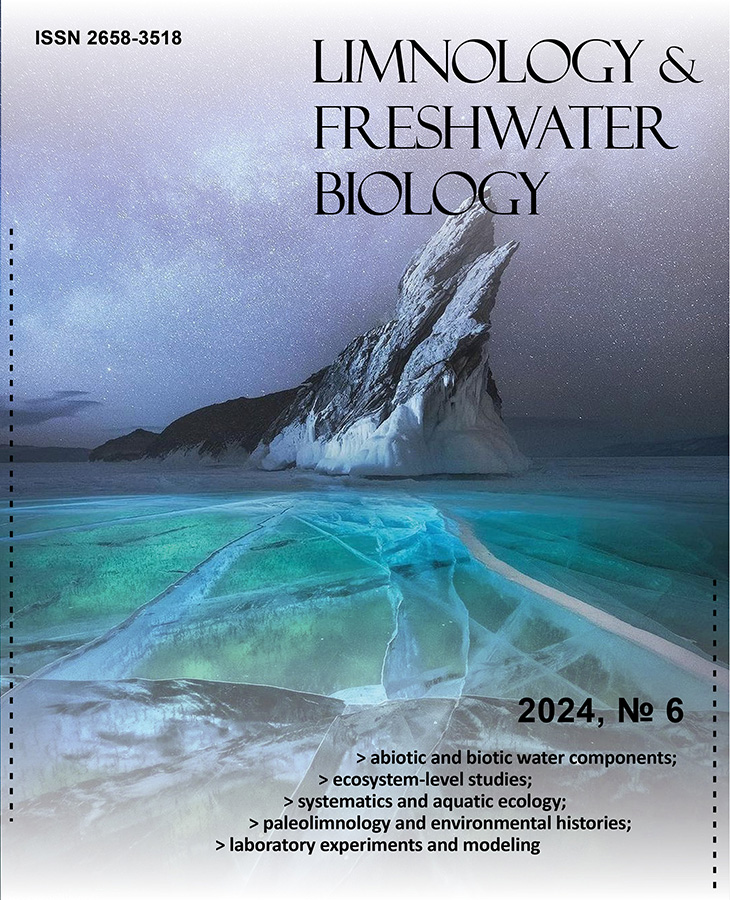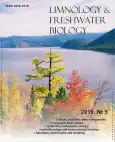№ 5 (2019)
Статьи
Changes in lipid composition and lipid peroxidation products content in the freshwater mussel Anodonta cygnea L. under cadmium effect
Аннотация
In order to identify specific biomarkers to cadmium-induced oxidative stress in freshwater organisms, changes in the composition of membrane and storage lipids and their fatty acids in the gills and digestive glands of freshwater mussels, Anodonta cygnea (Linnaeus, 1758), exposed to cadmium ions at 10, 50 and 100 µg/L were studied. Cadmium-induced oxidative stress was estimated by the content of lipid peroxidation products such as conjugated dienes and trienes, malondialdehyde, and Schiff bases. Accumulation of lipid peroxidation products in the gills and digestive glands reflected the intensity of lipid peroxidation, depending on the concentration and duration of cadmium exposure. Changes in the fatty acid composition of phospholipids and triacylglycerols reflected their compensatory role in the response of the mussels to the action of cadmium at various concentrations. Some indices of lipid composition (phosphatidylserine and triacylglycerol content) similarly altered under cadmium effect in both marine and freshwater mussels. The assessment of oxidative stress biomarkers and the main targets for these oxidative processes including lipids and their fatty acid composition makes it possible to identify protective biochemical mechanisms providing the high resistance of mussels to environmental pollution.
 286-296
286-296


Valve morphogenesis and silicon dynamics in the synchronized culture of Ulnaria danica
Аннотация
Formation of diatom siliceous cell walls occurs inside the cells and depends on the availability of silicon from the environment. In the current work we have studied the valve morphogenesis of a freshwater pennate diatom Ulnaria danica in a laboratory culture synchronized by silica starvation and absence of light. Approximate timelines were established for the initiation of valve synthesis and formation of its major components. It was shown that the silicon surge uptake takes place, e.g. silicon concentration in the medium reduces during the first 30 minutes after the addition of silicon to a synchronized culture. During the formation of main valve elements, intracellular silicon pool is lower than it is after the end of synchronization, returning to the original level only 90 minutes after the addition of silica and beginning of the morphogenesis.
 297-301
297-301


Fluorescent dyes for the study of siliceous sponges
Аннотация
New fluorescent dyes containing coumarine and rhodamine groups were applied as vital dyes capable of staining growing siliceous spicules of Baikal sponge Lubomirskia baicalensis (Pallas, 1773). Cultivation of the sponge primmorphs in the presence of fluorescent dyes allows the use of confocal microscopy to study the morphology of the spicules and, in the case of two-color staining, to draw some conclusions about the growth rate of the spicules. 5-6.5 months were estimated to be the time required for the full formation of the spicules.
 302-307
302-307


Structure features and structural transformations of the maxillary bones in the Baikal cottoid fish
Аннотация
In this paper, we study morphogeometric parameters and histostructure of maxillary bones in three coastal Baikal Cottoidei species belonging to different trophic groups. The results of the study revealed that the main trend in the transition from benthography to ichthyography is the sequential elongation of jaws and reduction in the mouth thrust accompanied by a consistent change in the form and internal structure of bone elements. A detailed analysis of data revealed that the changes mostly concern additional morphological structures (processes) of the bones directly connected with musculoligamentous apparatus and experiencing the highest tension during the functioning of the maxillary system. The distinctive features of the structural transformations maxillary bones in different fishes is a consequence of the uneven effect of power load that changes when the body adapts to certain habitat conditions.
 308-311
308-311


Evaluation of water suspension effect on spectral light attenuation in Novosibirsk Reservoir
Аннотация
The paper presents the measurement data (August 20 – 22, 2019) on spectral light attenuation in the Novosibirsk Reservoir waters in the range from 400 to 800 nm. In different sampling stations, attenuation (calculated on the natural logarithmic base) varied within 4.6 – 25.9 m–1. Relative transparency (42 – 140 cm) was measured using a Secchi disk. To assess the effect of water suspension on total attenuation, we calculated its relative spectral contribution and other main optically active components of water, i.e. yellow substance, chlorophyll a and pure water. Yellow substance and suspension showed the maximum contribution to light attenuation in the water from all 10 sampling stations of the reservoir. The spectral contribution of suspension was 30 – 60% in the range of 430 nm, 39 – 71% at 550 nm and 33 – 64% at 670 nm, respectively. The suspension was the second optically active component affecting spectral light attenuation.
 312-315
312-315











